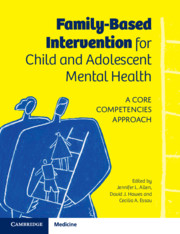Book contents
- Family-Based Intervention for Child and Adolescent Mental Health
- Family-Based Intervention for Child and Adolescent Mental Health
- Copyright page
- Contents
- Contributors
- Preface
- Part I Theoretical Perspectives on Family-Based Intervention
- Part II Core Clinical Competencies
- Part III Family Intervention for Specific Child and Adolescent Mental Health Problems
- Part IV Family Intervention for Children at Risk Due to Family Dysfunction or Past Adversity
- Chapter 16 Working with Parents with Depression in Family Intervention
- Chapter 17 Working with Parents with Anxiety in Family Intervention
- Chapter 18 Working with Families of Children Who Have Experienced Maltreatment
- Chapter 19 Working with Families and Children Exposed to Intimate Partner Violence
- Part V New Developments in Family-Based Intervention
- Index
- References
Chapter 18 - Working with Families of Children Who Have Experienced Maltreatment
from Part IV - Family Intervention for Children at Risk Due to Family Dysfunction or Past Adversity
Published online by Cambridge University Press: 18 February 2021
- Family-Based Intervention for Child and Adolescent Mental Health
- Family-Based Intervention for Child and Adolescent Mental Health
- Copyright page
- Contents
- Contributors
- Preface
- Part I Theoretical Perspectives on Family-Based Intervention
- Part II Core Clinical Competencies
- Part III Family Intervention for Specific Child and Adolescent Mental Health Problems
- Part IV Family Intervention for Children at Risk Due to Family Dysfunction or Past Adversity
- Chapter 16 Working with Parents with Depression in Family Intervention
- Chapter 17 Working with Parents with Anxiety in Family Intervention
- Chapter 18 Working with Families of Children Who Have Experienced Maltreatment
- Chapter 19 Working with Families and Children Exposed to Intimate Partner Violence
- Part V New Developments in Family-Based Intervention
- Index
- References
Summary
Child maltreatment is a universal public health issue. It is well established that parenting is implicated in both risk and resilience for child abuse and neglect. Thus, family-based interventions are significant for preventing and treating the psychological and developmental impact of child maltreatment. The aim of this chapter is to outline core competencies that clinicians should aspire to develop and strengthen to provide effective practice with families of children at risk for or exposed to maltreatment. To this end, we discuss scientific principles and evidence-informed strategies using a framework of three overarching competency domains underpinning therapeutic work in this field: (1) conceptualizing child maltreatment, (2) promoting wellbeing in families of children at risk for or exposed to maltreatment and (3) scientific and professional issues. We conclude by demonstrating the clinician competencies using a case illustration of a child presenting with complex trauma.
Keywords
- Type
- Chapter
- Information
- Family-Based Intervention for Child and Adolescent Mental HealthA Core Competencies Approach, pp. 242 - 257Publisher: Cambridge University PressPrint publication year: 2021
References
- 1
- Cited by

